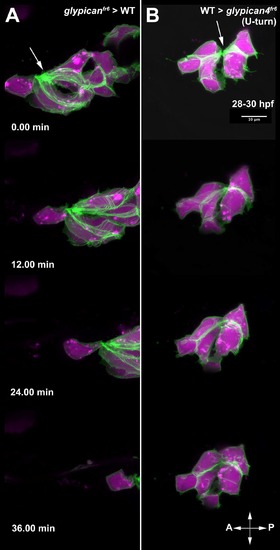Fig. S6
- ID
- ZDB-FIG-161229-25
- Publication
- Venero Galanternik M. et al., 2016 - Glypican4 Modulates Lateral Line Collective Cell Migration Non Cell-Autonomously
- Other Figures
- All Figure Page
- Back to All Figure Page
|
glypican4fr6 mutant primordium cells migrate like wild type cells when transplanted into a wild type embryo. (A) Clone of glypican4fr6 mutant cells (Magenta+/GFP+) in a wild type primordium shows that mutant cells properly migrate toward the tail tip suggesting that the wild type environment rescued them. (B) Wild type primordium clone (Magenta+/GFP+) in a glypican4fr6 mutant environment. The wild type cells become rounder and they do not migrate posteriorly confirming a non-cell autonomous effect of glypican4. White arrows point to rosette constrictions in the primordium. See Movie S4. Anterior is to the left, and posterior is to the right. |
Reprinted from Developmental Biology, 419(2), Venero Galanternik M., Lush, M.E., Piotrowski, T., Glypican4 Modulates Lateral Line Collective Cell Migration Non Cell-Autonomously, 321-335, Copyright (2016) with permission from Elsevier. Full text @ Dev. Biol.

